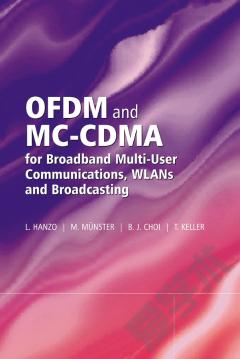OFDM-Based Broadband Wireless Networks —— Design and Optimization
----- OFDM型宽带无线网络:设计与优化
Preface. 1. Introduction. 1.1 OFDM-based wireless network overview. 1.1.1 Digital broadcasting and DVB-T. 1.1.2 Wireless LAN and IEEE 802.11. 1.1.3 WiMAX and IEEE 802.16. 1.2 The need for "cross-layer" design. 1.3 Organization of this text. 2. OFDM Fundamentals. 2.1 Broadband radio channel characteristics. 2.1.1 Envelope fading. 2.1.2 Time dispersive channel. 2.1.3 Frequency dispersive channel. 2.1.4 Statistical characteristics of broadband channels. 2.2 Canonical form of broadband transmission. 2.3 OFDM realization. 2.4 Summary. 3. PHY Layer Issues - System Imperfections. 3.1 Frequency synchronization. 3.1.1 OFDM carrier offset data mode. 3.1.2 Pilot-based estimation. 3.1.3 Non-pilot based estimation. 3.2 Channel estimation. 3.2.1 Pilots for 2D OFDM channel estimation . 3.2.2 2DMMSE channel estimation. 3.2.3 Reduced complexity channel estimation. 3.3 I/Q imbalance compensation. 3.3.1 I/Q Imbalance Model. 3.3.2 Digital compensation receiver. 3.3.3 Frequency offset estimation with I/Q imbalance. 3.4 Phase noise compensation. 3.4.1 Mathematical models for phase noise. 3.4.2 CPE estimation with channel state information. 3.4.3 Time domain channel estimation in the presence of CPE. 3.4.4 CPE estimation without explicit CSI. 3.5 Summary. 4. PHY Layer Issues - Spatial Processing. 4.1 Antenna array fundamentals. 4.2 Beam forming. 4.2.1 Coherent combining. 4.2.2 Zero-forcing. 4.2.3 MMSE reception (optimum linear receiver). 4.2.4 SDMA. 4.2.5 Broadband beam forming. 4.3 MIMO channels and capacity. 4.4 Space-time coding. 4.4.1 Spatial multiplexing. 4.4.2 Orthogonal space-time block coding. 4.4.3 Concatenated ST transmitter. 4.4.4 Beam forming with ST coding. 4.4.5 ST beam forming in OFDM. 4.5 Wide-area MIMO beam forming. 4.5.1 Data model. 4.5.2 Uncoded OFDM design criterion. 4.5.3 Coded OFDM design criterion. 4.6 Summary. 4.7 Appendix I: Derivation of Pe. 4.8 Appendix II: Proof of Proposition 5. 4.9 Appendix III: Proof of Proposition 6. 5. Multiple Access Control Protocols. 5.1 Introduction. 5.2 Basic MAC protocols. 5.2.1 Contention based protocols. 5.2.2 Non-contention based MAC protocols. 5.3 OFDMA advantages. 5.4 Multiuser diversity. 5.5 OFDMA optimality. 5.5.1 Multiuser multicarrier SISO systems. 5.5.2 Multiuser multicarrierMIMO systems. 5.6 Summary. 5.7 Appendix I: Cn(p) is a convex function in OFDMA/SISO case. 5.8 Appendix II: C(p) is a convex function in OFDMA/MIMO case. 6. OFDMA Design Considerations. 6.1 Cross layer design introduction. 6.2 Mobility-dependent OFDMA traffic channels. 6.2.1 OFDMA traffic channel. 6.2.2 System model. 6.2.3 Channel configuration for fixed/portable applications. 6.2.4 Channel configuration for mobile application. 6.3 IEEE 802.16e traffic channels. 6.4 Summary. 7. Frequency Planning in Multi-cell Networks. 7.1 Introduction. 7.1.1 Fixed channel allocation. 7.1.2 Dynamic channel allocation. 7.2 OFDMA DCA. 7.2.1 Protocol design. 7.2.2 Problem formulation for the RNC. 7.2.3 Problem formulation for BSs. 7.2.4 Fast algorithm for the RNC. 7.2.5 Fast algorithm for BSs. 7.3 Spectrum efficiency under different cell/sector configurations. 7.3.1 System configuration and signaling overhead. 7.3.2 Channel loading gains. 7.4 Summary. 8. Appendix. 8.1 IEEE 802.11 and WiFi. 8.1.1 802.11 overview. 8.1.2 802.11 network architecture. 8.1.3 The MAC layer technologies. 8.1.4 The physical layer technologies. 8.2 IEEE 802.16e and Mobile WiMAX. 8.2.1 Overview. 8.2.2 The physical layer technologies. 8.2.3 The MAC layer technologies. 8.3 Performance analysis of WiMAX systems. 8.3.1 WiMAX OFDMA-TDD. 8.3.2 Comparison Method. Notations and Acronym. About the Authors. Index.
{{comment.content}}








 京公网安备 11010802027623号
京公网安备 11010802027623号